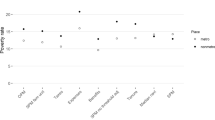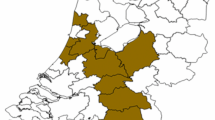Abstract
Using restricted administrative data on the voucher program, we examine the experience of voucher holders in metropolitan areas with rising rents. While some of our models suggest that rising rents in metropolitan areas are associated with a slight increase in rent-to-income ratios among voucher holders, poor renters in general see significantly larger increases in rent-to-income ratios. We see little evidence that rising rents push voucher holders to worse neighborhoods, with voucher holders in central cities ending up in lower poverty neighborhoods as rents rise. It appears that vouchers may help low-income households remain in neighborhoods as they gentrify.

Similar content being viewed by others
Notes
In addition, annual data on rents at the census tract level are not available, and even five-year estimates from ACS are noisy.
In certain circumstances, households earning up to 80% of the area median income can receive a voucher.
During this time period, HUD allowed FMRs to be set at median rent in selected metropolitan areas where voucher holders were concentrated in a limited number of census tracts. Collinson and Ganong (2018) find this shift had no effect on voucher holder location.
He limits sample to households with nonzero income.
Alaska, Hawaii, Puerto Rico, and the other unincorporated territories are excluded from our sample.
We use the Core Based Statistical Area (CBSA) delineations based on the 2010 standards that were announced by the Office of Management and Budget in 2013. Although we have 238 unique CBSAs, not each of them is observed in all years. Some small CBSAs have missing information on racial composition and/or share of high-school dropouts. Among the 238 CBSAs that we consider, 118 have complete demographic information for the 9 years (2006–2014), 16 have demographic information for 8 years, 7 have demographic information for 7 years, 13 have demographic information for 6 years, 8 have demographic information for 5 years, 11 have demographic information for 4 years, 21 have demographic information for 3 years, 19 have demographic information for 2 years, and 25 have demographic information for only one year.
When we estimate CBSA-level models that compare the HCV and the IPUMS samples, the sample of CBSAs falls to 156 because the CBSA of residence is missing for some households in the IPUMS sample.
Census tracts are defined according to the boundaries from the 2010 delineations. The ACS waves for years 2006–2010, 2007–2011, 2008–2012, 2009–2013, and 2010–2015 are in 2010 boundaries. We crosswalk estimates from 2005–2009, which are in 2000 boundaries, to 2010 boundaries.
We find qualitatively the same results when we link voucher data from 2005 through 2009 to neighborhood conditions as reported in 2005–09 five-year ACS data and link voucher data from 2010 through 2014 to neighborhood conditions as reported in 2010–14 five-year ACS data.
We also run opportunity models using years 2007–2014 and obtain similar results. In this set of models, tract attributes for years 2007 and 2008 are obtained from the 2000 Census.
While the gross rents charged to voucher holders rise with CBSA median rents, they should be more strongly associated with rents in the submarkets where voucher holders tend to rent (though these two rent measures are highly correlated).
IPUMS models include the same set of household controls than the HCV models except for dummies for building type.
We cannot distinguish between moves within and across Census tracts in the IPUMS sample.
We obtain similar results when we aggregate to CBSA and estimate long-change regressions examining link between increases in CBSA rent and increases in rent burden between 2006 and 2014.
We compute exposure for all poor families because publicly available tract data from the American Community Survey do not report separate counts of poor renters.
References
Center on Budget and Policy Priorities. 2017. Housing Choice Voucher Fact Sheets. https://www.cbpp.org/housing-choice-voucher-fact-sheets.
Collinson, Robert, Ingrid Gould Ellen, and Jens Ludwig. 2016. Low Income Housing. In Economics of Means-Tested Transfer Programs in the United States, vol. II, ed. Robert Moffit. Chicago, IL: University of Chicago Press.
Collinson, Robert, and Peter Ganong. 2018. How Do Changes in Housing Voucher Design Affect Rent and Neighborhood Quality? American Economic Journal: Economic Policy 10(2): 62–89.
Dawkins, Casey and Jae Sik Jeon. 2017. Rent Burden in the Housing Choice Voucher Program. Multidisciplinary Research Team Report. Washington, DC: Department of Housing and Urban Development.
Ellen, Ingrid Gould, Keren Horn, and Katherine O’Regan. 2013. Why Do Higher Income Households Choose Low Income Neighborhoods? Pioneering or Thrift? Urban Studies 50(12): 2478–2495.
Ellen, Ingrid Gould, Keren Horn, and Amy Ellen Schwartz. 2016. Why Don’t Housing Choice Voucher Recipients Live Near Better Schools? Insights from Experimental and Big Data. Journal of Policy Analysis and Management 35: 884–905.
Finkel, Meryl, and Larry Buron. 2001. Study of Section 8 Voucher Success Rates Volume 1: Quantitative Study of Success Rates in Metropolitan Areas. Washington, DC: U.S. Department of Housing and Urban Development, Office of Policy Development and Research.
Galvez, Martha. 2011. Defining ‘Choice’ in the Housing Choice Voucher Program. Dissertation Manuscript, New York University.
Jacob, Brian A., and Jens Ludwig. 2012. The Effects of Housing Assistance on Labor Supply: Evidence from a Voucher Lottery. American Economic Review 102(1): 272–304.
McClure, Kirk. 2005. Rent Burdens in the Housing Choice Voucher Program. Cityscape: A Journal of Policy Development and Research 8(2): 5–20.
Mills, Gregory, Daniel Gubits, Larry Orr, David Long, Judie Feins, Bulbul Kaul, Michelle Wood, Amy Jones & Associates, Cloudburst Consulting, and the QED group. 2006. The Effects of Housing Vouchers on Welfare Families. Washington, D.C.: U.S. Department of Housing and Urban Development, Office of Policy Development and Research.
NYU Furman Center. 2016. National Affordable Rental Housing Landscape. 2016. https://furmancenter.org/files/NYU_Furman_Center_Capital_One_National_Affordable_Rental_Housing_Landscape_2016_9JUNE2016.pdf.
Author information
Authors and Affiliations
Corresponding author
Additional information
Publisher's Note
Springer Nature remains neutral with regard to jurisdictional claims in published maps and institutional affiliations.
The work that provided the basis for this publication was supported by funding from the U.S. Department of Housing and Urban Development, Office of Policy Development and Research and from the Annie E. Casey Foundation. The substance and findings of the work are dedicated to the public. The author and publisher are solely responsible for the accuracy of the statements and interpretations contained in this publication. Such interpretations do not necessarily reflect the views of the Government.
Rights and permissions
About this article
Cite this article
Ellen, I.G., Torrats-Espinosa, G. Do Vouchers Protect Low-Income Households from Rising Rents?. Eastern Econ J 46, 260–281 (2020). https://doi.org/10.1057/s41302-019-00159-y
Published:
Issue Date:
DOI: https://doi.org/10.1057/s41302-019-00159-y




